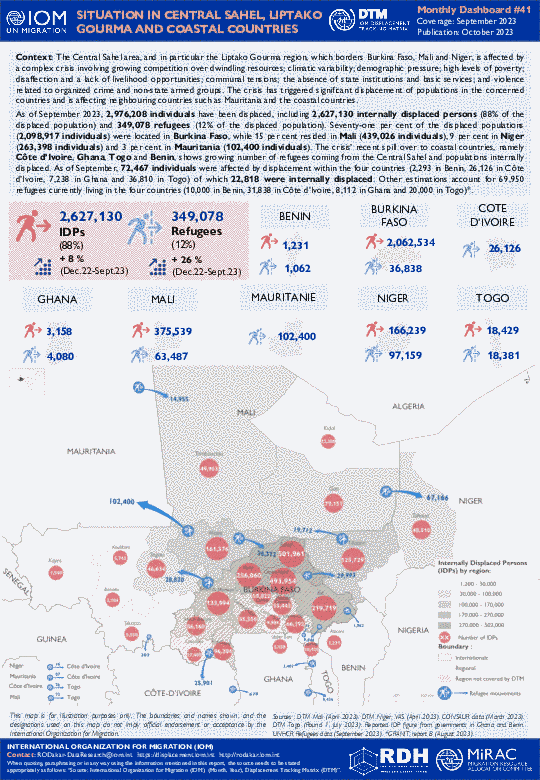-
Countries
-
Data and Analysis
-
Special Focus
-
Crisis Responses
West and Central Africa — Liptako Gourma Crisis Monthly Dashboard 41 (September 2023)
The Central Sahel area, and in particular the Liptako Gourma region, which borders Burkina Faso, Mali and Niger, is affected by a complex crisis involving growing competition over dwindling resources; climatic variability; demographic pressure; high levels of poverty; disaffection and a lack of livelihood opportunities; communal tensions; the absence of state institutions and basic services; and violence related to organized crime and non-state armed groups. The crisis has triggered significant displacement of populations in the concerned countries and is affecting neighbouring countries such as Mauritania and the coastal countries.
As of September 2023, 2,976,208 individuals have been displaced, including 2,627,130 internally displaced persons (88% of the displaced population) and 349,078 refugees (12% of the displaced population). Seventy-one per cent of the displaced populations (2,098,917 individuals) were located in Burkina Faso, while 15 per cent resided in Mali (439,026 individuals), 9 per cent in Niger (263,398 individuals) and 3 per cent in Mauritania (102,400 individuals). The crisis’ recent spill over to coastal countries, namely Côte d’Ivoire, Ghana, Togo and Benin, shows growing number of refugees coming from the Central Sahel and populations internally displaced. As of September, 72,467 individuals were affected by displacement within the four countries (2,293 in Benin, 26,126 in Côte d’Ivoire, 7,238 in Ghana and 36,810 in Togo) of which 22,818 were internally displaced. Other estimations account for 69,950 refugees currently living in the four countries (10,000 in Benin, 31,838 in Côte d’Ivoire, 8,112 in Ghana and 20,000 in Togo)*.

